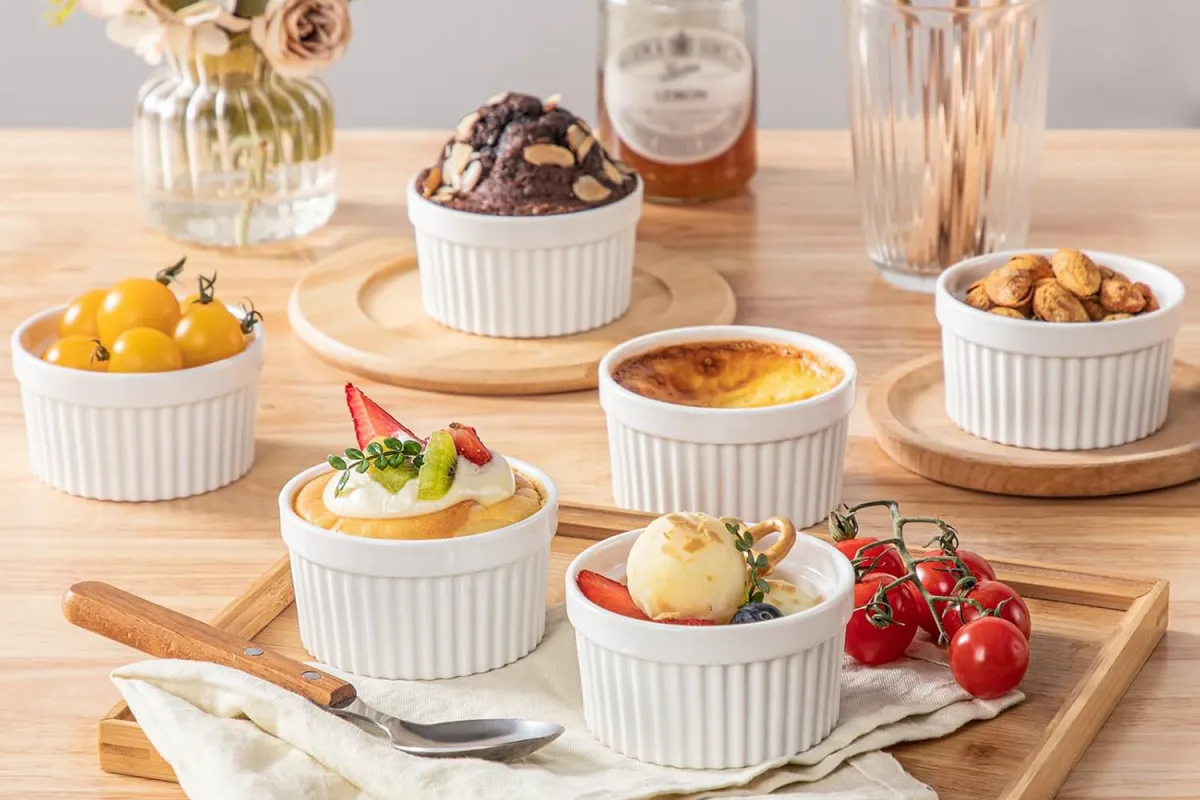Crème brûlée is a classic French dessert that many people associate with fine dining. Its creamy custard base topped with a crisp, caramelized sugar crust makes it a favorite among dessert lovers. Traditionally, crème brûlée is served in ramekins—small, individual dishes that are ideal for the job. But do you really have to use ramekins for crème brûlée, or are there suitable alternatives? In this article, we’ll explore the role of ramekins in making crème brûlée, discuss possible substitutes, and provide practical tips for achieving the perfect dessert no matter what dish you use.
Introduction to Crème Brûlée and the Use of Ramekins
Crème brûlée has long been a symbol of sophistication and elegance. This dessert, which translates to “burnt cream,” is known for its smooth, velvety custard and the contrasting texture of its caramelized sugar topping. The dessert is typically served in individual ramekins, which are small, round dishes made of ceramic, glass, or porcelain. But why are ramekins the go-to choice for crème brûlée, and what makes them so effective?
The Importance of Ramekins
Ramekins are traditionally used for crème brûlée because they help achieve the perfect texture and consistency. The size and shape of ramekins allow for even cooking, ensuring that the custard is set just right—firm but not overly stiff. Additionally, ramekins are perfect for portion control, making it easy to serve individual desserts that look as good as they taste.
If you’re curious about the different types of dishes that can be used for crème brûlée, you might want to check out this guide on Choosing the Right Dish for Crème Brûlée.
The Versatility of Ramekins
While ramekins are the traditional choice, they are by no means the only option. Some home bakers wonder if it’s possible to use other types of dishes for crème brûlée. The short answer is yes, but with some caveats. The dish you choose can affect both the cooking process and the final result, so it’s important to understand the pros and cons of using different types of dishes.
For those looking to explore alternative methods for caramelizing sugar without a blowtorch, Caramelizing Sugar Without a Blowtorch offers some handy tips.
Why Ramekins Are Typically Used for Crème Brûlée
Ramekins have become synonymous with crème brûlée for several reasons. They are not just traditional; they serve practical purposes that enhance the quality of the dessert.
Even Cooking
One of the primary reasons ramekins are used for crème brûlée is their ability to promote even cooking. The small size and round shape of ramekins ensure that the custard cooks uniformly, preventing overcooking or undercooking. This is crucial for achieving the perfect texture—a custard that is firm yet still creamy.
Portion Control
Ramekins also make it easy to manage portion sizes. Each ramekin holds just the right amount of custard, making it convenient to serve individual portions. This not only adds to the presentation but also helps maintain consistency in cooking.
Presentation
There’s no denying that ramekins contribute to the visual appeal of crème brûlée. The small, elegant dishes create a restaurant-quality presentation that elevates the dining experience. The contrast between the smooth custard and the crisp, caramelized sugar topping is more pronounced when served in individual ramekins.
Exploring Alternative Dishes for Crème Brûlée
While ramekins are the traditional choice, you can use other types of dishes for crème brûlée. However, these alternatives come with their own set of challenges and benefits.
Shallow Ceramic Dishes
Shallow ceramic dishes can be a good substitute for ramekins. They allow for a similar cooking process and can achieve a comparable texture. The main difference is that shallow dishes offer more surface area, which can be advantageous if you enjoy the caramelized sugar topping. However, keep in mind that these dishes may require slight adjustments in cooking time.
Glass Dishes
Glass dishes are another option for making crème brûlée. They are non-reactive and can withstand the heat of the oven, making them suitable for custards. However, glass dishes are more prone to cracking under extreme heat, especially when caramelizing the sugar topping. If you choose to use glass, it’s important to monitor the baking process closely and avoid sudden temperature changes.
Mugs and Cups
If you’re in a pinch, you can use mugs or cups as an alternative to ramekins. While these are not the traditional choice, they can work in a home setting. The key is to ensure that the mugs or cups are oven-safe. The challenge with using mugs or cups is that they often have thicker walls, which can affect how evenly the custard cooks. Additionally, the depth of the mug may require a longer baking time.
Large Baking Dishes
For those who prefer to make a larger batch of crème brûlée, a large baking dish can be used instead of individual ramekins. This approach is less traditional but can be practical for serving a crowd. However, there are some trade-offs. Baking crème brûlée in a large dish can result in uneven cooking, with the edges setting faster than the center. Additionally, it can be more challenging to achieve a uniform caramelized topping.
Pros and Cons of Using Ramekins vs. Alternatives
When deciding whether to use ramekins or an alternative dish for crème brûlée, it’s important to weigh the pros and cons of each option.
Ramekins
- Pros:
- Even heat distribution: Ramekins ensure that the custard cooks uniformly.
- Portion control: Ideal for serving individual portions.
- Aesthetic appeal: Ramekins add to the visual presentation of the dessert.
- Cons:
- Limited to small portions: Ramekins are designed for individual servings, which may not be ideal for larger gatherings.
- Can be expensive: High-quality ramekins can be costly, especially if you need several for a larger batch.
Alternatives
- Pros:
- Flexibility in serving sizes: Larger dishes allow you to make bigger portions or serve multiple people from a single dish.
- More accessible: Many people already have suitable alternative dishes at home, such as ceramic or glass baking dishes.
- Cons:
- Uneven cooking: Larger or non-traditional dishes may result in uneven cooking, with some areas overcooked while others remain undercooked.
- Challenges with caramelization: Achieving a consistent caramelized sugar topping can be more difficult in non-traditional dishes.
How to Adjust Cooking Techniques When Not Using Ramekins
If you decide to use an alternative dish for your crème brûlée, there are a few adjustments you may need to make to ensure the best results.
Adjusting Baking Time
Different dishes may require adjustments in baking time. For example, a larger dish will generally require a longer baking time to ensure that the custard sets properly in the center. On the other hand, a shallower dish may cook faster. It’s important to keep a close eye on the custard and check for doneness by gently shaking the dish—if the custard jiggles slightly in the center, it’s ready.
Caramelizing Sugar
Achieving the perfect caramelized sugar topping is one of the hallmarks of crème brûlée. If you don’t have a kitchen torch, you can use your oven’s broiler to caramelize the sugar. However, this method can be tricky, especially if you’re using a non-traditional dish. The key is to place the dish close to the broiler and keep a constant watch to prevent burning. For more tips, you can explore Caramelizing Sugar Without a Blowtorch.
Temperature Considerations
Different materials conduct heat differently, which can affect the baking process. For example, glass and ceramic dishes retain heat longer than metal, so it’s important to allow the custard to cool gradually to avoid overcooking. Additionally, if you’re using a larger dish, consider reducing the oven temperature slightly and extending the baking time to ensure even cooking.
Serving and Presentation Tips with Alternative Dishes
Even if you’re not using ramekins, you can still achieve an elegant presentation for your crème brûlée. Here are some tips for making your dessert look just as appealing in alternative dishes.
Enhancing Visual Appeal
- Decorative Toppings: Add fresh berries, edible flowers, or a dusting of powdered sugar to enhance the visual appeal of your crème brûlée.
- Creative Serving Ideas: Serve crème brûlée in non-traditional containers, such as teacups or mini jars, for a creative twist. Just make sure they are oven-safe!
- Garnishes: A sprig of mint or a drizzle of fruit coulis can add a pop of color and flavor to your presentation.
Pairing with Accompaniments
Crème brûlée pairs beautifully with a variety of accompaniments, whether served in ramekins or alternative dishes:
- Fresh Berries: The tartness of fresh berries like raspberries or blueberries complements the sweetness of the custard.
- Fruit Compote: A dollop of fruit compote adds a contrasting texture and enhances the overall flavor.
- Espresso or Dessert Wine: Serve crème brûlée with a shot of espresso or a glass of dessert wine to balance the richness of the custard.
FAQs
Can I Use a Ceramic Dish for Crème Brûlée?
Yes, you can use a ceramic dish for crème brûlée. Ceramic dishes are excellent at retaining heat, which can help the custard cook evenly. Just be mindful of the size and depth of the dish, as this may require adjustments in baking time.
How Do I Prevent the Custard from Curdling in Larger Dishes?
To prevent the custard from curdling, it’s important to cook it gently and evenly. Use a water bath to regulate the temperature and ensure even cooking. Additionally, be sure to temper the eggs properly by gradually adding the warm cream to avoid scrambling.
Is It Necessary to Use a Water Bath with Non-Ramekin Dishes?
Yes, a water bath is recommended regardless of the dish you use. The water bath creates a humid environment in the oven, which helps the custard cook gently and evenly. This prevents the custard from becoming rubbery or developing cracks on the surface.
What’s the Best Way to Caramelize Sugar Without a Kitchen Torch?
If you don’t have a kitchen torch, you can caramelize the sugar topping under your oven’s broiler. Place the dish on the top rack, close to the broiler, and keep a close eye on it. The sugar will caramelize quickly, so be sure to remove the dish as soon as the sugar turns golden brown.
How Do I Store Crème Brûlée Made in a Large Dish?
If you’ve made crème brûlée in a large dish, you can store it in the refrigerator for up to two days. Cover the dish tightly with plastic wrap to prevent the custard from absorbing any odors from the fridge. Before serving, you can caramelize the sugar topping for a fresh, crunchy finish.
Conclusion: Final Thoughts on Using Ramekins vs. Alternatives
Ramekins are the traditional choice for making crème brûlée, and for good reason—they provide even cooking, control portion sizes, and enhance the dessert’s presentation. However, if you don’t have ramekins or prefer to experiment with other dishes, there are several viable alternatives. Whether you use shallow ceramic dishes, glass containers, mugs, or a large baking dish, it’s possible to achieve a delicious crème brûlée with the right adjustments to your cooking technique.
Ultimately, the choice of dish comes down to personal preference and what you have available in your kitchen. With a little creativity and attention to detail, you can enjoy the luxurious taste of crème brûlée in any form.

